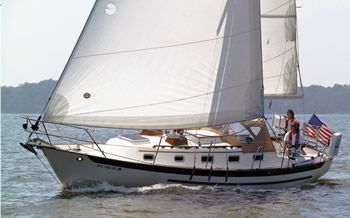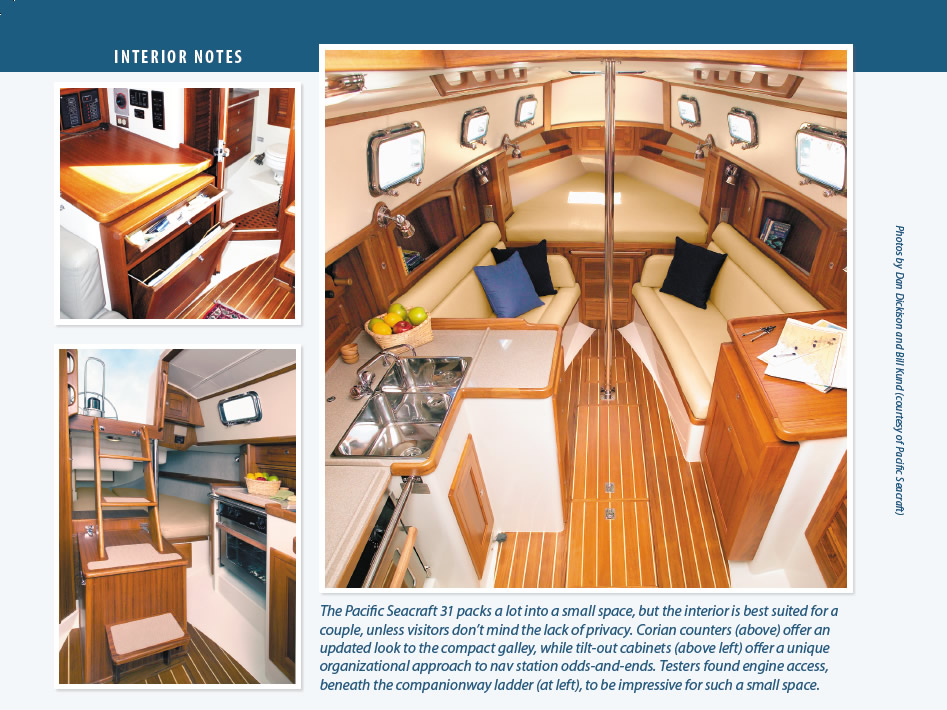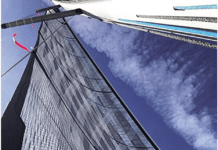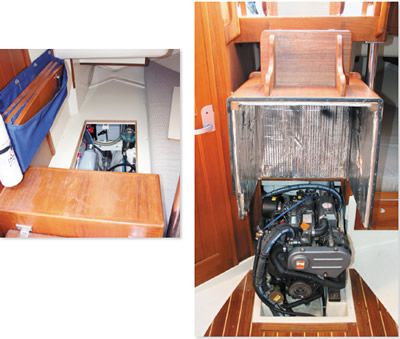Photo courtesy of Pacific Seacraft

Readers familiar with the work of William Crealock-the renowned designer of the Crealock 37, the Cabo Rico 34, the Dana 24, and at least 30 other production-built vessels-understand that his designs are steeped in practicality. Crealock famously wrote: Seaworthiness in a cruising boat has to be the No. 1 consideration. It doesn’t matter how cute the boat is if it doesn’t get [to the destination] in one piece. And those familiar with his life are aware that his knowledge of sailing wasnt just grounded in the study of design, but also in extensive hands-on experience at sea-an imperative for any designer of boats intended for offshore.
History
As a young man, Crealock completed his degree in naval architecture and worked in a Glasgow shipyard for several years. Afterward, he spent nearly eight years cruising the Atlantic and Pacific oceans under sail. A portion of that time was invested as first mate and navigator aboard a 110-foot schooner. Though the young Brit cut his teeth in yacht design working on large-scale commercial vessels, his expertise matured during the golden age of fiberglass production boatbuilding-the 1960s-in what was then the industrys epicenter: Southern California.
Because Crealock knew the exigencies of offshore sailing firsthand, he conceived his designs accordingly. The Pacific Seacraft 31 exists in that vein. Introduced in 1987, its heritage can be traced to 1984, when Pacific Seacraft commissioned Crealock to produce a smaller version of his then-popular Crealock 37. Initially, he drew a 34-foot adaptation, but several years later, he condensed the design into the 31-foot package that is reviewed here. (The company did build a full-keel, double-ended 31 model dubbed Mariah from 1977 to 1983, but that was an entirely different boat.)
Production of the Pacific Seacraft 31 ran until 1999, and 79 boats were built. Production resumed in 2002. However, in May 2007-after completing 129 of the 31s-the company filed for bankruptcy. A few months later, the majority of its assets were purchased by Steve Brodie and his father, Reid, of Washington, N.C. The duo moved the tooling for all models except the Dana 24 and the rest of the operation to their homebase across the country via 21 tractor-trailer loads, and began building sailboats under the name Pacific Seacraft.
Its important to note that the Brodies convinced many of the companys key personnel to make the move East as well, including the overall production manager, the mold shop manager, plumbing, mechanical, and electrical managers, the touchup and detail supervisor, several master carpenters, and skilled tradesmen. According to the company, this cadre of individuals represented hundreds of years of experience building Pacific Seacraft boats.
The boat PS tested for this review was hull No. 129, the last one built at the California plant.
Design
Pacific Seacrafts design brief for the 31 was straightforward. This vessel was intended to have all the essential elements to qualify as a world-voyaging yacht. In fact, those words appeared in the marketing literature that promoted this model upon its introduction. And specifically, Pacific Seacraft intended for the 31 to appeal to cruising couples.
Similar in design to its immediate forebearers, the 31 has a proportionally broader beam and a longer waterline. The intent here was to produce reasonable speed under sail as well as comfortable motion and enhanced handling. The hull begins with a relatively fine, high bow and deep forefoot that extends aft accompanied by a subtly concave sheerline. Beneath its 24-foot, 2-inch waterline, the 31 sports a modified fin keel and a skeg-hung rudder. But the stern section is a definite departure from Crealocks design norm. Instead of the rounded, double-ended configuration seen on the 34 and many of his other designs, the 31 has a broad, flat transom that enables easier stern boarding and allows for a sizeable quarterberth.
The 31 comes in two keel options, a shoal-draft version that draws 4 feet as well as a standard version that draws 4 feet, 11 inches. According to Steve Brodie, having a shoal-draft option was important, because although we anticipate that these boats will sail in the open ocean, theyll also be used a lot around the southeast Atlantic coast and in the Gulf Coast area. And, it turns out that theyre popular in this region.
Aloft, this boat features a single-spreader, extruded aluminum mast supporting a cutter rig and 600 square feet of sail area (though a sloop rig option with 485 square feet is also available). Down below, the company opted for an open interior instead of the privacy afforded by segmented cabins. (Joseph Artese, who designed the interior of the 90-foot sloop Whitefin, was commissioned to conceive the 31s layout.) The styling is intentionally contemporary with a simple layout that the marketing literature describes as versatile.
by Bill Kund

Deck Details
The boat that PS tested was built in 2007 and is one of the few 31s with a Seldn anodized aluminum mast. (Historically, Pacific Seacraft delivered the 31 with powder-coated aluminum spars as standard equipment, a practice the Brodies are continuing.) The in-mast furling aboard our test boat is also not standard.
The boat that PS tested also has the optional low-maintenance package, which includes stainless grabrails instead of teak and an aluminum toerail instead of a teak caprail.
Nearly a third of the space on deck is occupied by the cockpit, which despite its low coamings, is well protected by the high cabin trunk, a deep footwell, and an optional dodger. Except for the two-speed, self-tailing Harken 40 primary winches, the coaming isn’t encumbered by hardware, affording additional seating in moderate conditions. The 6-foot, 2-inch cockpit seats are sufficiently long for a full-sized adult to stretch out fore and aft, yet they narrow to just 8 inches adjacent the steering pedestal.
Despite the 30-inch, stainless-steel Edson steering wheel and the 12- by 24-inch instrument pod that sits above it (an owner option), the helmsman can easily move forward to tend the halyard tails alongside the companionway. The sightlines forward from the raised helmsmans seat are clear.
Athwartships of the steering pedestal are cubbies recessed into the coaming that are 10 inches deep by 18 inches long and 4 inches high. Protected by a teak fiddle, theyre sufficiently sized to keep winch handles or handheld VHFs, etc., handy yet secure.
Beneath the helmsmans seat is a sizeable rear lazarette. Both port and starboard cockpit seats also have locking lids that access additional lazarette storage. On the transom, the owner of our test boat had an anchor roller mounted to port, which is a good feature if it can be placed appropriately to be both out of the way and securely mounted. Headroom beneath the optional bimini that covers the cockpit is a full 6 feet, 4 inches; however, this does obscure the view of the mainsail from the helm.
Embedded in the cockpit sole are 2-inch scuppers situated in the aft corners of the footwell. The owner of our test boat attested that this positioning comes with one drawback: An inch or two of standing water can accumulate in the forward part of the footwell under power at full throttle.
The companionway is well protected on either side by the cabin trunk and is fitted with a beefy hatch system overhead. The owner of our test boat opted for saloon-style teak doors instead of drop boards, which gave him the option of swapping out screens in the doors for solid panels.
At the aft end of the bridgedeck, the 31 has a Garhauer traveler that spans 36 inches and is controlled by a 4:1 purchase. Except for Harken winches and Ronstan turning blocks for the halyards and reeflines, most of the sailhandling hardware aboard our test boat was from Garhauer. The mast and boom are Seldn sections, and the boomvang is a Seldn Boomkicker. On new boats, standard hardware is all Harken.
The nonskid in the cockpit footwell and on deck is a raised diamond pattern that provides better grip than recessed grooves. Adjacent the cabintop, the sidedecks are just over 12 inches wide at the narrowest point. Amidships, just inboard of the 4-inch-high bulwark, there are scuppers on either side of the boat that drain overboard (through the deck and hull, and just outboard of those are hawseholes meant for spring lines, yet there were no cleats in that vicinity on the test boat; new PS31s do have midship cleats. The toerail is capped stem to stern with an optional, perforated aluminum strip intended to serve for anchoring snatchblocks, etc.
The chainplates (stainless-steel tangs measuring a quarter inch by 1.5 inches by 12 inches) are affixed outboard to the hull by way of half-inch, stainless-steel bolts run through a full backing plate inside the hull. The position of the chainplates means that the shrouds don’t obstruct fore and aft crew movement along the sidedecks. The cabintop is fitted with stainless grabrails on each side, and all of the portlights (five on each side) and their mounting hardware are polished stainless steel.
Both aft pushpit and the forward pulpit are mounted with stainless, hex head No. 12 bolts. The pushpit, which extends nearly 30 inches off the deck, is split into port and starboard sections to allow for a centerline boarding ladder on the transom. The optional bimini is mounted on the upper rail of the pushpit, meaning less hardware mounted to the deck and a cleaner application all around.
The pulpit extends aft just beyond the inner forestay, and its forward legs are integrated into a stout, stainless-steel anchor platform that houses two anchor bow rollers and a terminus for the headstay.
Accommodations
The openness of the interior is augmented by the choice of off-white gelcoat for the fiberglass, complemented by teak drawer and cabinet door faces and trim. The layout offers maximum space for a few individuals. For example, though they lack doors for privacy, both the quarterberth and the V-berth offer 6 feet, 6 inches of length with at least 5 feet of breadth. Standing headroom throughout the cabin is 6 feet, 1 inch. And every light downbelow or on deck is an LED fixture.
Adjacent the companionway, a compact galley sits to port and the head sits to starboard, cordoned off by the vessels lone interior door. The galley houses a gimbaled, two-burner stove, a double-well, stainless-steel sink, and sufficient storage areas outboard and within the main cabinet to accommodate foodstuffs and cooking implements for a full week on board. The surfaces here are Corian, an owner option.
A 5-cubic-foot icebox sits across the cabin with a teak lid that does double duty as the chart table. Tilt-out compartments on the inboard side of the icebox cabinet accommodate navigation tools and charts. Just outboard of the chart table is the main electrical panel, which is a marvel of organizational simplicity.
The head compartment is a combination of easy-to-clean, gelcoated surfaces complemented by handcrafted teak doors, trim, and a teak shower grate on the sole. There is ample storage here for personal hygiene items and first-aid materials. At the aft end of the compartment is a wet locker accessed by a 16-inch by 20-inch opening covered by louvered teak doors. The commode is fitted with bronze through-hull valves and a bronze base. Ventilation here and throughout the cabin is accomplished by way of seven 10-inch, opening ports. Theres also a 20-inch by 20-inch hatch at the forward end of the cabin.
Attention to detail is evident downbelow. The teak joinery is flawless. A sturdy, vinyl headliner has zippered seams to allow access to wiring and deck hardware fasteners. On either side of the cabin are settees that extend under the V-berth when a forward cushion is removed to offer a full 7 feet of length. (Each settee can fitted with lee cloths to serve as a functional seaberth for passagemaking.)
Outboard of each upright settee cushion are storage compartments for bedding or other bulky items. Between the settees, firmly anchored into the keel sump under the teak and holly sole, is a stainless-steel compression post that also supports a unique, centerline saloon table that slides out from beneath the V-berth. Even the cushions are well made, with stainless-steel snaps engineered into a separate outer flap so that they can be more easily attached.
Perhaps the most impressive aspect of the interior is the easy access to the engine compartment for service. In fewer than 10 seconds, you can remove the companionway ladder, tilt open the insulated teak box that surrounds the engine, and have nearly 270 degrees of access. You can check the oil, the impeller, the water, and the wiring harness here, though access to the transmission fluid dipstick is more challenging. Access to the stuffing box requires removing a quarterberth cushion and a small panel beneath it.
Performance
The boat that PS tested was fitted with a shoal-draft Scheel keel. Aside from draft, the only difference between this model and the conventional, deeper keel is that this version produces a smaller bilge, limiting the size of the fuel tank to five fewer gallons.
Under power with the 30-horsepower Yanmar diesel churning at 2,400 to 2,600 rpms, the sound in the cabin registered an acceptable 90 decibels. At these rpms, in flat water, the boat cruised at 5.3 knots against a slight headwind. The owner told PS that the engine typically burns a half-gallon per hour under such conditions. The engine controls are all within easy reach of the helm.
This particular 31 is fitted with an in-mast furling mainsail, giving the boat a working sailplan of 485 square feet. With the full main and headsail close-hauled, and the wind between 10 and 14 knots, the 31 slid along through a 1-foot chop at 3.6 knots. When the wind speed increased to a steady 15 knots, the boat speed increased to 4.2 knots, requiring only minor sail-trim adjustments.
The owner told us that he typically sails upwind with full main and headsail. In winds above 20 knots, he furls the genoa and replaces it with the inner headsail. We took an alternate approach when the winds reached 16 knots and furled the mainsail to 60 percent. That configuration tamed the boats motion, decreased the heel upwind and enhanced speed by 2/10 to 3/10 of a knot.
The boat responded well to the 30-inch helm and Edson gear-steering system. Despite its lengthy fin keel, the 31 has a relatively tight turning radius and an acceptable amount of headway loss during tacks for cruising. In 18.7 knots of wind and a 1-foot chop, the 31 tacked from a heading of 45 degrees to 115 degrees, coming out of the tack with about 3.8 knots of speed. This is impressive given that this particular boat was fitted with a fixed, 12-inch, three-bladed prop.
Downwind and broad reaching, under the same sail configuration of a partially reefed main and full genoa, the boat moved at 6.7 knots and was very easy to steer. The rig aboard our test boat is fitted with running backstays, which appear to be overkill, in our opinion. However, the owner said they are handy in big blows and at anchor so that the mast wont pump in strong winds.
Underway, the cockpit easily accommodates four people; five would be comfortable as well, but a larger group would push it beyond cozy. The primary winches are close enough to the helm to be tended from there, which is ideal for solo sailing. However, their outboard placement means that rotation of the winch handle is obstructed by the lower lifeline; a problem that needs to be addressed.
Conclusion
Boatbuilder Steve Brodie told PS that the companys clients rarely compare the Pacific Seacraft 31 to other production-built sailboats of this size and intent. That implies the 31s singularity, which is borne of Crealocks simple outlook on design. When the designer passed away in 2009, Blanca Gonzalez of the San Diego Union-Tribune, wrote in his obituary: As a child in his native England, if he didnt know the answer on an exam, he just drew a picture of a boat. The straightforward nature of that statement captures the essence of the 31. Despite its diminutive size, this is a capable, offshore cruising vessel with no other pretensions. There are numerous testimonies from owners who have experienced bluewater voyaging aboard their 31s in many parts of the world.
Like those owners, we were impressed. Specifically, we like the 31s open, well-apportioned interior and its easy-to-navigate cockpit and deck. We like the attention to detail evident in its quality of finish. And though we were disappointed by its limited upwind speed in lighter wind ranges, for a 31-footer displacing 11,000 pounds, those speeds arent unexpected.
Depending upon your perspective, there are just two other conceivable drawbacks. At a base cost of $270,000 for a new model, the 31 is certainly pricey for a boat this size; however, a good-condition used model can be found in the $75,000 to $125,000 range. Also, it would be challenging to accommodate a second couple on board overnight without privacy issues. If you can abide those concerns, and youre in the market for a reliable, compact, offshore vessel, the Pacific Seacraft 31 should be on your short list.








































